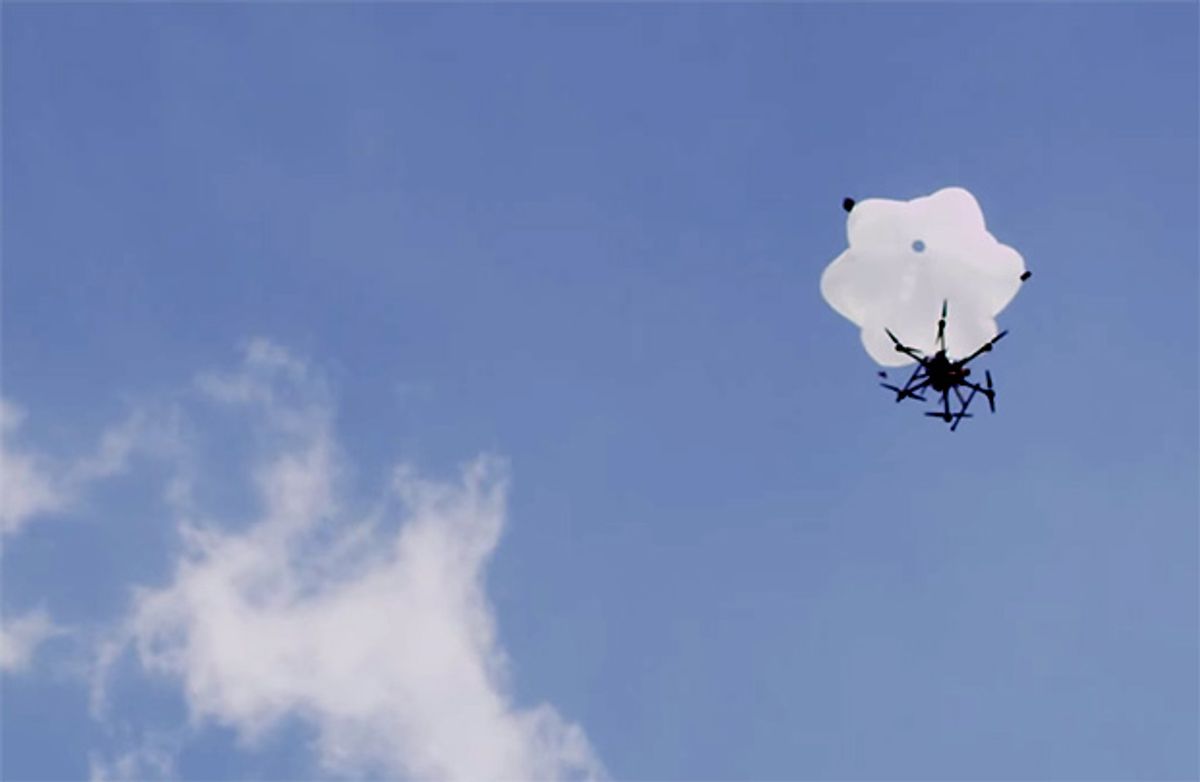There's been a bunch of drone stuff going on this week, and we thought that it might be easiest for you (and for us) to toss it all at you at once. It's sort of like Video Friday, except Drone News Thursday. And no, this will not be a recurring feature (I hope), so enjoy it while it lasts.
The more drones there are flying around over our heads, the more likely it is that some of those drones will, for whatever reason, fall out of the sky. This is bad for the drones, but probably worse for anyone directly underneath them.
Drone maker DJI has come up with a drone-mounted parachute deploying system that can drop your expensive aerial investment gently (ish) to the ground in the event of an emergency:
Here are the specs we've been able to dig up on the DJI DropSafe (which hasn't been officially released yet):
- Compatible with DJI S1000, S800 EVO, and S800 systems
- Compatible with DJI A2 and WooKong-M flight control systems
- Supports command inputs from RC transmitters
- An independent RC control channel is reserved for parachute deployment. Additionally, a backup battery safeguards the system, so if the main battery fails, users can still deploy the parachute manually.
- Automatically cuts off motor power when parachute is deployed
- Payload – Speed of descent
- 3 kg – 4.4 m/s
- 6 kg – 5.6 m/s
- 9 kg – 6.8 m/s
- 12 kg – 8.6 m/s
- 15 kg – 11.7 m/s
Important: The DJI DropSafe parachute is designed to minimize damage to equipment in the event of an accident. However, no guarantee can be made that all damage will be prevented. Use with caution.
The chute is reusable, and the entire system weighs about 550 grams. It'll deploy itself in half a second, which makes it effective at altitudes as low as 6 meters.
"Coming soon," whatever that means.
Via [ SUAS News ]
So now that you've got a fancy new parachute on your drone, time to go fly it! Here's a map of places to avoid:
Basically, you're not allowed to fly around airports or military bases, or (most recently) in national parks. This map doesn't (yet) take local rules into effect, but the data are open source, and hopefully it'll grow along with any decisions made by local authorities or the FAA.
An important thing to remember: just because a given area isn't labeled as a no-fly zone on this map doesn't mean that it's legal to fly there! And just because it's legal to fly somewhere doesn't mean that it's a good idea.
[ Mapbox ] via [ DIY Drones ]
The FAA has a deadline of September 2015 by which it's supposed to find a way to safely integrate drones into national airspace. At this rate, it may not make it, and even if it does, that's more than a year away, and in the meantime, people are flying drones all over the place anyway.
Besides safety and airspace concerns, there are also privacy issues, and according to Politico, President Obama is going to try to get out ahead of things with an executive order:
President Barack Obama plans to issue an executive order to develop privacy guidelines for commercial drones operating in U.S. airspace, POLITICO has learned.
The order would put the National Telecommunications and Information Administration, an arm of the Commerce Department, in charge of developing the guidelines. NTIA would bring together companies and consumer groups to hammer out a series of voluntary best practices for unmanned aerial vehicles.
There's no date for this, and the White House isn't commenting.
Via [ Politico ]
Evan Ackerman is a senior editor at IEEE Spectrum. Since 2007, he has written over 6,000 articles on robotics and technology. He has a degree in Martian geology and is excellent at playing bagpipes.



